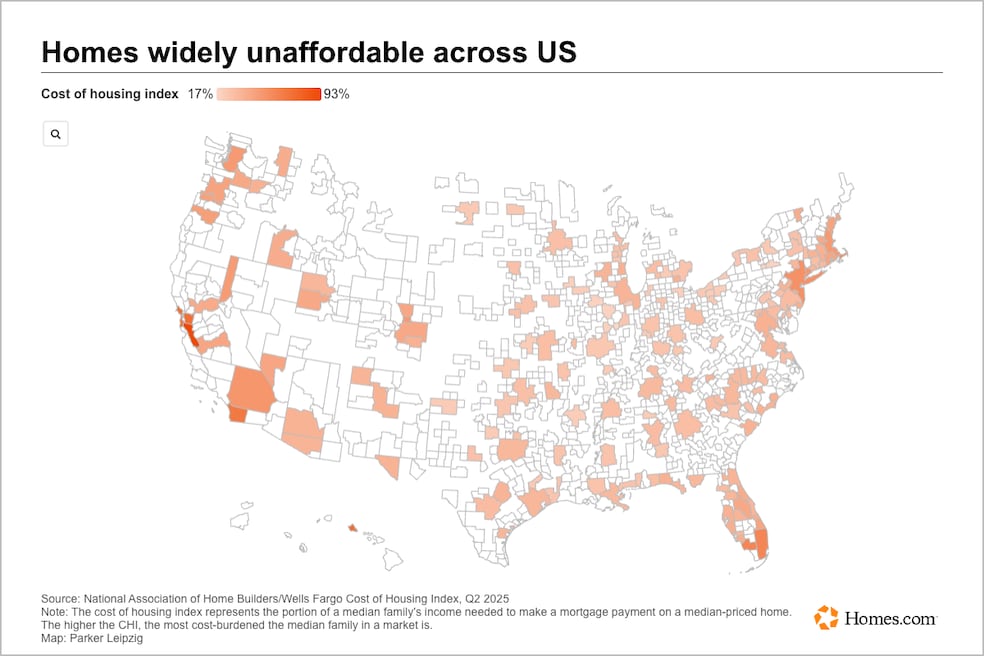The gap between the cost of newly built and existing homes widened last quarter, and the push to find housing before school started may have contributed to it, a new report suggests.
What hasn't changed is that both categories of homes remain unaffordable.
The mortgage for a median-priced new home required about 36% of the pay of a median-income individual earning $104,200, according to August data from the National Association of Home Builders/Wells Fargo Cost of Housing Index. An existing home, however, took about 37%. The U.S. Department of Housing and Urban Development defines cost-burdened families as those “who pay more than 30% of their income for housing,” and a severe cost burden is defined as paying more than 50% of one’s income on housing.
For low-income homebuyers over the same period, or those earning 50% or less of the median income, a new-home mortgage cost 71% of their income, and an existing home required 74%.
While that second-quarter snapshot emphasized the unaffordability of new and existing homes, it also suggested a narrowing cost-burden gulf between new and existing homes. In its announcement accompanying the data, NAHB stated that the “second quarter of 2025 marked the largest historical gap where existing home prices exceeded those of new homes,” pointing toward builders offering lower-priced options while sticky mortgage rates and narrow inventory keep existing home prices elevated.
In reality, said Laurie Goodman, founder of the Housing Finance Policy Center at the Urban Institute, summer buying trends are weighing on the data. Goodman is also a fellow with the Washington, D.C.-based think tank.
“One issue with the existing home sale series is that there is a very strong seasonal pattern,” Goodman told Homes.com via email. Larger existing homes, she explained, tend to “disproportionately sell” in the second quarter and the beginning of the third quarter “so families can get settled before the start of the new school year.”
New home sales, she noted, do not display a similar pattern.
But Goodman did agree that, over a more expansive time span, “prices on new and existing homes are converging, as new homes are getting smaller and developers are offering incentives.”
Still, Goodman said, “I believe new homes are still more expensive, and the NAHB results are skewed by the seasonal pattern in existing home sales.”
Buddy Hughes, NAHB chairman, said that "builders have been working diligently to make new homes more affordable by reducing square footage, lowering prices and offering a host of buyer incentives."
“The Cost of Housing Index shows these efforts have moved the needle in the right direction, but much more needs to be done on the policy front to reduce regulatory burdens, address construction labor shortages and ease building material supply chains to allow builders to increase the nation’s housing supply,” said Hughes, a home builder and developer from Lexington, N.C.
Coasts are cost-burdened
Cost burdens of new and existing homes weren’t uniform across the United States.
Overall, 10 out of the 175 markets analyzed were severely cost-burdened, NAHB reported, meaning that buyers had to spend more than half of their income on a median-priced existing home. Eighty-five markets were cost-burdened (with buyers spending between 31% and 50%), and 80 markets required 30% or less.
The most cost-burdened markets were often found along the coast, with San Jose-Sunnyvale-Santa Clara, California, needing 93% of the average income to buy an existing home; Urban Honolulu, Hawaii, requiring 73%; San Francisco-Oakland-Fremont, California, taking 72%; San Diego-Chula Vista-Carlsbad, California, at 67%; and Florida’s Naples-Marco Island and Miami-Fort Lauderdale-West Palm Beach markets both at 60%.
On the flip side, Illinois and New York had the least cost-burdened markets in the second quarter. Decatur, Illinois, needed only 17% of a buyer’s income on average; Elmira, New York, asked 18%; Peoria, Illinois, required 19%, as did Davenport-Moline-Rock Island, Iowa-Illinois, and Binghamton, New York.

